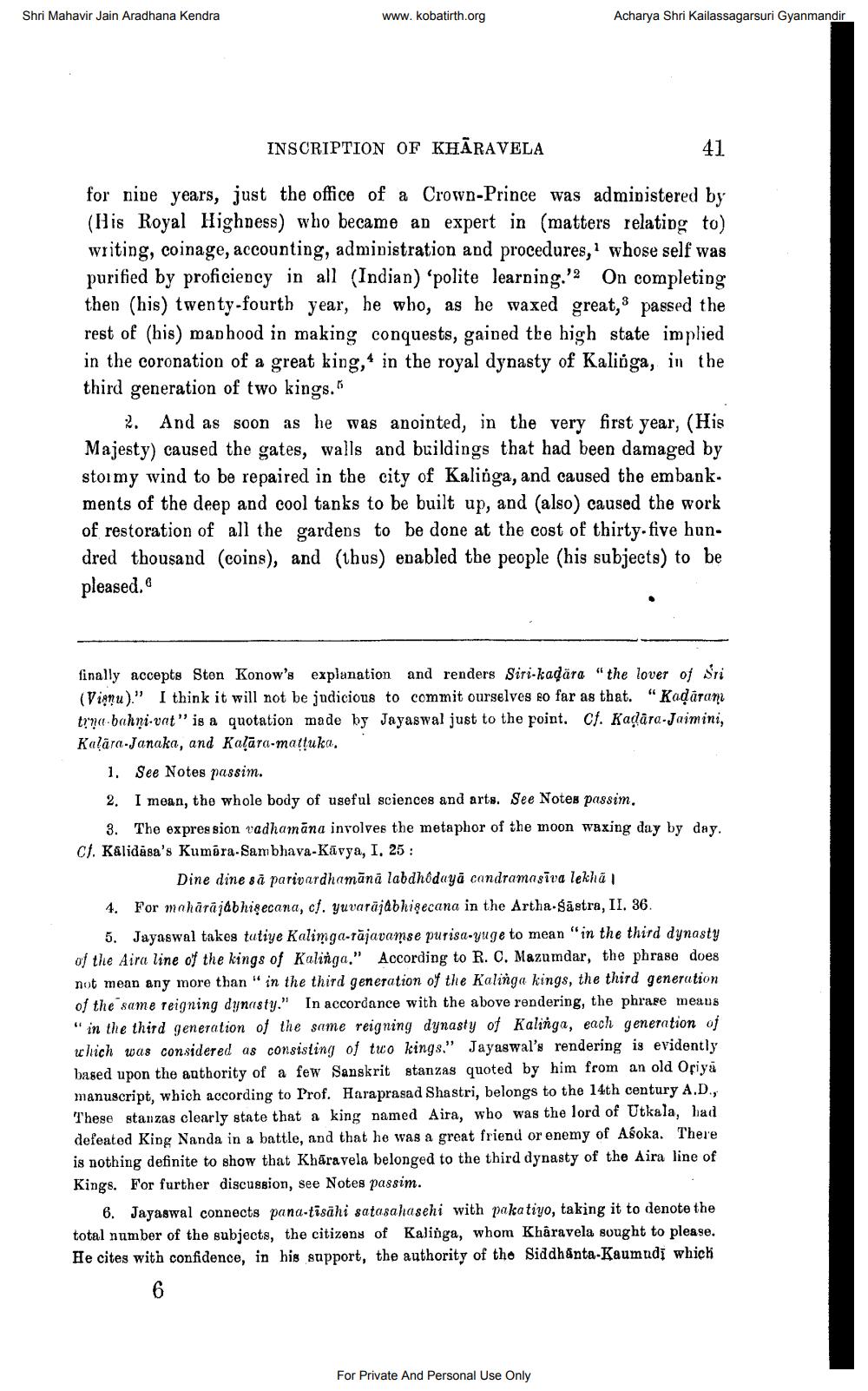________________
Shri Mahavir Jain Aradhana Kendra
www.kobatirth.org
Acharya Shri Kailassagarsuri Gyanmandir
INSCRIPTION OF KHARAVELA
41
for nine years, just the office of a Crown-Prince was administered by (His Royal Highness) who became an expert in (matters relating to) writing, coinage, accounting, administration and procedures, whose self was purified by proficiency in all (Indian) 'polite learning.'2 On completing then (his) twenty-fourth year, he who, as he waxed great, passed the rest of (his) manhood in making conquests, gained the high state implied in the coronation of a great king, in the royal dynasty of Kalinga, in the third generation of two kings."
2. And as soon as he was anointed, in the very first year, (His Majesty) caused the gates, walls and buildings that had been damaged by stormy wind to be repaired in the city of Kalinga, and caused the embankments of the deep and cool tanks to be built up, and (also) caused the work of restoration of all the gardens to be done at the cost of thirty-five hun dred thousand (coins), and (thus) enabled the people (his subjects) to be pleased."
finally accepts Sten Konow's explanation and renders Siri-kadara "the lover of Sri (Vienu)." I think it will not be judicious to commit ourselves so far as that. "Kadaram trna-bahni-vat" is a quotation made by Jayaswal just to the point. Cf. Kadara-Jaimini, Kalara-Janaka, and Kalara-maṭṭuka.
1. See Notes passim.
2. I mean, the whole body of useful sciences and arts. See Notes passim.
3. The expression vadhamana involves the metaphor of the moon waxing day by day. Cf. Kalidasa's Kumara-Sambhava-Kavya, I, 25:
Dine dine sa parivardhamana labdhodaya candramasīva lekha |
4. For maharajabhişecana, cf. yuvarajabhişecana in the Artha-Sastra, II. 36.
5. Jayaswal takes tutiye Kalimga-rajavamse purisa-yuge to mean "in the third dynasty of the Aira line of the kings of Kalinga." According to R. C. Mazumdar, the phrase does not mean any more than "in the third generation of the Kalinga kings, the third generation of the same reigning dynasty." In accordance with the above rendering, the phrase meaus. "in the third generation of the same reigning dynasty of Kalinga, each generation of which was considered as consisting of two kings." Jayaswal's rendering is evidently based upon the authority of a few Sanskrit stanzas quoted by him from an old Oriya manuscript, which according to Prof. Haraprasad Shastri, belongs to the 14th century A.D., These stanzas clearly state that a king named Aira, who was the lord of Utkala, had defeated King Nanda in a battle, and that he was a great friend or enemy of Asoka. There is nothing definite to show that Kharavela belonged to the third dynasty of the Aira line of Kings. For further discussion, see Notes passim.
6. Jayaswal connects pana-tisähi satasahasehi with pakatiyo, taking it to denote the total number of the subjects, the citizens of Kalinga, whom Kharavela sought to please. He cites with confidence, in his support, the authority of the Siddhanta-Kaumudi which
6
For Private And Personal Use Only




